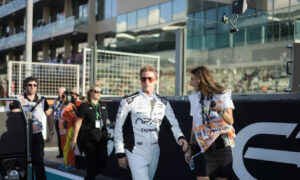

On June 27, 2025, the high-octane world of Formula 1 will blur the line between sports and cinema when F1, directed by Joseph Kosinski, races into theaters. With Brad Pitt and Damson Idris in lead roles, the film is more than another sports drama—it’s a hybrid of Hollywood storytelling and trackside realism, created with intimate access to the pulse-pounding world of elite motorsport.
Produced by Jerry Bruckheimer, with seven-time World Champion Lewis Hamilton serving as a key creative partner, F1 intends to redefine the racing film genre by fusing narrative, spectacle, and authenticity. Kosinski—known for his stylized, kinetic direction in Top Gun: Maverick and Tron: Legacy—has set his sights on crafting an immersive experience that not only represents the sport but places audiences inside it.
Plot: Redemption and Mentorship on the Grand Prix Circuit
At the epitome of F1 lies the story of Sonny Hayes (Brad Pitt), a once-celebrated Formula 1 driver who faded into obscurity after a career-ending accident in the 1990s. Decades later, he’s drawn back into the limelight—not as a competitor but as a mentor to Joshua “Noah” Pearce (Damson Idris), a talented but unproven rookie.
The duo joins APXGP, a fictional eleventh team on the Formula 1 grid, created for the film to interact naturally with real-life teams like Mercedes-AMG Petronas, Ferrari, and Red Bull Racing. This narrative construct allows the film to interlace fictional arcs with documentary-level immersion, making APXGP a narrative device and technical marvel—its livery, cars, and branding existing in real F1 paddocks during race weekends.
Their journey is not only about crossing finish lines but about navigating internal conflict, public scrutiny, and the balance of legacy versus ambition. In classic sports-drama fashion, F1 mines emotional depth from high-speed peril, giving it the potential to become a Rush or Creed for the next generation.
Authenticity: Filming at Speed, In Real Time
Where most sports films rely on green screens or staged replays, F1 bucks tradition with real track access and real speeds. Pitt and Idris underwent rigorous training to operate specially modified Formula 2 cars, customized by Mercedes engineers to look and feel like Formula 1 machines.
These aren’t mere replicas. The APXGP cars reached up to 180 mph during actual Grand Prix weekends—a feat coordinated with Formula One Management (FOM) to minimize disruption. Filming occurred during live events at circuits like:
- Silverstone (UK)
- Spa-Francorchamps (Belgium)
- Monza (Italy)
- Yas Marina (UAE)
In these environments, Kosinski utilized a bespoke camera rig, borrowing innovations from the Top Gun: Maverick production. This system allows micro-cameras to be embedded inside the cockpit, capturing G-forces, helmet POVs, and the violent ballet of apex cornering in vivid, near-first-person clarity.
It’s a visual approach designed to feel like racing, not merely depict it. Kosinski calls it “cinematic telemetry”—data, narrative, and motion fused into a visual experience that’s never been done at this scale in motorsports cinema.
Flow with the F1 Ecosystem
Integral to this ambition is the deep collaboration with the F1 community, led by Lewis Hamilton, whose creative input anchors the film in real-world experience. As co-producer, Hamilton influenced script choices, technical accuracy, and even pit-lane etiquette.
“We want to represent the sport in the right light,” Hamilton said in an Apple TV+ teaser. “We want to capture the passion, the risks, and the sheer skill it takes to drive at this level.”
Real F1 drivers, including Max Verstappen, Carlos Sainz, and Charles Leclerc, make appearances—some scripted, others organic—as the film crew integrated seamlessly into the 2023 and 2024 race calendars. According to Pitt, the ethos on set was “deference”: “We told every driver and team, if we’re in your way, let us know. We’ll get out. This is your world—we’re just borrowing it.”
The film’s production team shadowed real engineers, team principals, and tire strategists to understand and replicate the granular rhythm of F1 weekends. APXGP’s pit wall scenes aren’t imagined—they’re choreographed realism, down to telemetry displays and tire compound debates.
The Visual Language of Velocity
The filmmaking challenges of F1 weren’t just technical but philosophical. How do you show speed without it becoming repetitive? Kosinski’s answer lies in perspective layering: aerial drone shots, cockpit cams, driver eye-tracking, and slow-motion tire deformation—all calibrated to highlight both scale and stakes.
Cinematographer Claudio Miranda, who won the Academy Award for Life of Pi, uses heat shimmer, rubber debris, and mid-race fog to convey texture. His lens doesn’t just show racing—it feels like carbon fiber screaming over asphalt at 300 km/h.
Aesthetically, the film is styled with an editorial polish—Pitt’s wardrobe, Idris’s rookie gear, and the paddock interiors evoke the real-life sponsorship clutter and hyperbranding of modern F1. Logos, liveries, and even the press rooms are recreated with granular detail, often using real crews and journalists as extras.
Soundtrack: The Pulse of a Generation
The upcoming soundtrack album, F1: The Album, offers another layer of crossover appeal. Curated to mirror the adrenaline of modern motorsport, it features:
- Don Toliver – moody, nocturnal trap
- Doja Cat – genre-blurring electro-pop
- Rosé (of BLACKPINK) – melodic introspection
- Hans Zimmer – orchestral urgency fused with analog synths
Zimmer’s score underpins the film’s emotional arcs, invoking everything from pit lane heartbreak to post-race euphoria. The composer, who also scored Rush and Inception, described his approach as “high RPM melancholy”—music that rides between introspection and overload.
Zimmer composed with telemetry feedback in mind, letting data like engine RPM and tire temperature inform musical tempo, giving scenes an almost organic rhythm that mirrors what the drivers feel on track.
Cultural Impact: A New Chapter in F1’s Cinematic Legacy
While Formula 1 has long inspired documentaries (Senna, Schumacher, Drive to Survive), F1 marks a deliberate shift into mainstream narrative cinema. With the sport’s popularity soaring globally—especially in the U.S.—the film arrives at a cultural inflection point.
The impression of Netflix’s Drive to Survive cannot be overstated: it built F1’s American fanbase, brought dramatic storytelling into garages, and positioned drivers like Lando Norris and George Russell as cultural icons. F1 the film continues this trajectory, but with the polish and permanence of feature cinema.
In doing so, it may influence:
- Fashion: Expect APXGP merch drops and collaborative pieces with streetwear brands.
- Music: Tracks from the film are expected to chart globally.
- Cinema: Hollywood may revisit how it approaches sports storytelling—real data, real speed, real sweat.
The Human Element: Beyond the Helmet
At its core, F1 is not merely about racing but about comeback, redemption, and risk. Pitt’s Sonny Hayes represents the archetype of a man outpaced by time but still obsessed with proving something—if not to the world, then to himself. Idris’s Noah Pearce, on the other hand, is the fresh face of a sport defined by legacy dynasties and impossible expectations.
Their dynamic, according to early test screenings, anchors the film emotionally. This isn’t just about gear changes and tire strategies—it’s about failure, fear, and the fragile ego behind the helmet.
It’s also a rare film that doesn’t pit young against old, but rather aligns them—mentorship is the engine, and the sport is the track.
Distribution and Streaming: A Hybrid Release
Distributed by Warner Bros. Pictures, F1 will receive a global theatrical release, followed shortly by streaming on Apple TV+, which helped co-finance the film alongside Formula One Group and Dawn Apollo Films.
Apple’s involvement reflects the tech giant’s broader ambitions in sports and streaming. With their recent acquisitions of Major League Soccer rights and increasing investment in original films (Napoleon, Killers of the Flower Moon), F1 aligns with Apple’s vision of producing prestige cinema at the intersection of culture and commerce.
A Landmark in Motorsport Storytelling
F1 is more than a film. It’s an event, a technical showcase, and potentially a watershed moment in how Hollywood engages with sport.
Kosinski, Hamilton, Pitt, and the entire cast and crew have not merely staged a racing drama—they’ve built a cinematic chassis that runs on precision, emotion, and reverence. Whether or not F1 claims awards or box office glory, it has already redefined expectations for what a racing movie can be: kinetic, immersive, and unmistakably human.
For filmgoers and racing fans alike, F1 offers something rare—a front-row seat not just to speed, but to story.
No comments yet.








